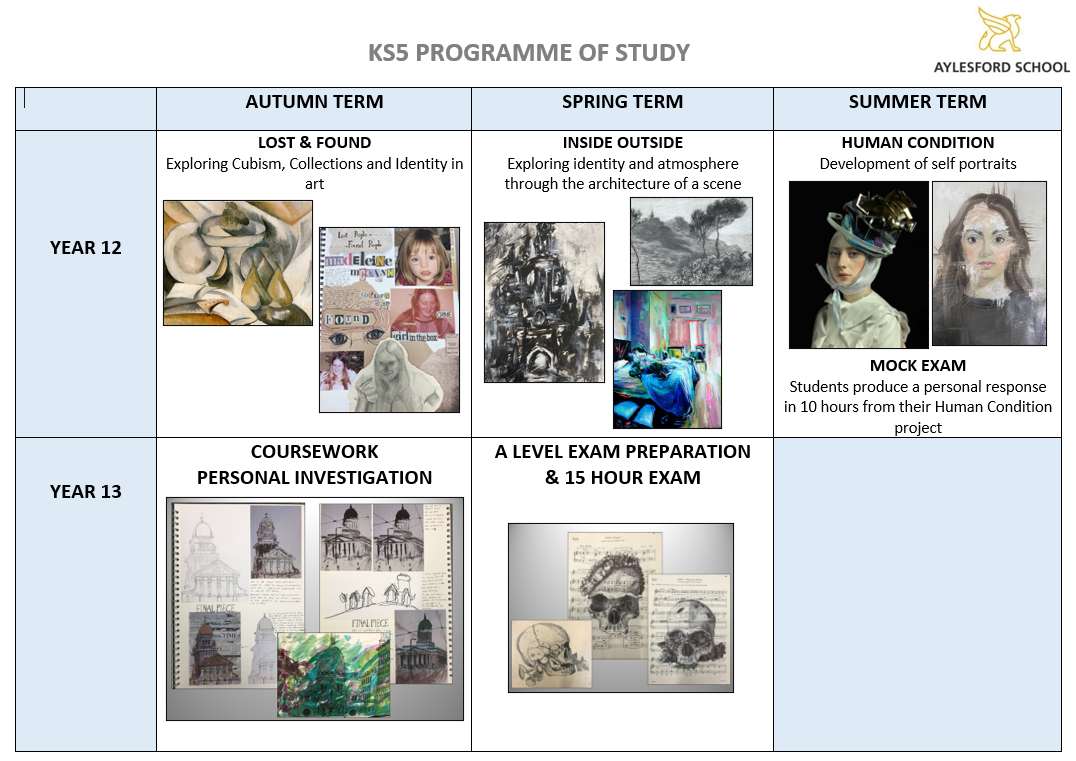| Key Topic: |
Lost & Found |
Inside Outside |
The Human Condition |
| New Knowledge: |
- Students are shown and taught how to develop a project from concept to final outcome.
- Understand and analyse the work of a range of artists; their purpose, techniques and subject matter. Artists that they will research are; Georges Braque, Juan Gris, Michael Craig Martin and Noble & Webster.
|
- Students are encouraged to continue to develop an independent project showing thorough connections and explorations of the theme.
- Understand and analyse the work of a range of artists; their purpose, techniques and subject matter. Artists they will research are Ian Murphy and John Virtue.
|
- Students are encouraged to develop an independent and individual project that will lead to the mock exam.
- Students will start to develop deeper meanings into their projects linking to social and moral issues.
- Students work in exam conditions for 10 hours to produce a final outcome inspired by an artist of their choice. Reflection on marks for mock exam prior to starting the self-directed project.
- To experiment with emotion and colour symbolism.
|
| Previous Knowledge Required: |
- Brainstorm ideas visually
- Photo shoot skills
- To make decisions about a suitable artist to influence their design and gain an understanding of that artist’s purpose, techniques and subject matter.
- Drawing objects from observation. Looking at shape, space and pattern.
- Experiment with a range of different materials, exploring different drawing techniques.
- Explore different techniques to apply tone, colour and texture.
- To experiment with composition, space and collage.
- Develop the ability to make decisions and work through refining and modifying ideas/ processes independently to create personal and meaningful responses that realise students’ intentions.
|
- Drawing inside and outside environments from observation.
- Experiment with a range of different materials, exploring different techniques.
- Develop processes such as ink and wash and charcoal.
|
- Drawing portraits and the human form from observation. Looking at proportion, form and features of the face.
- Experiment with a range of different materials, exploring different drawing techniques.
- Understand and analyse the work of a range of artists; their purpose, techniques and subject matter.
-
|
| New Skills: |
- Develop processes such as the use of pattern and repeating patterns in compositions.
- Introduction to Cubism
- Students encouraged to weave independent artist research into their projects.
- Students shown how to develop an independent project and the processes to achieve a successful narrative through a guided process.
- Creating a unique final piece inspired by an artist of their choice.
|
- Selecting and recording landscapes from first hand observation using mixed media techniques.
- Working on large scale compositions.
|
- Oil painting, focusing on colour mixing and application of paint.
|
| Links to the School Curriculum: |
- Textiles – repeat patterns
- Photography
|
|
- Biology
- Psychology
- Photography
|
| Independent Activities: |
- Visit art galleries and museums to see art first hand and make connections with your own work. Evidence this in your sketchbook.
- Those who are aiming for the highest grades need to work independently to produce more than the minimum amount of work which is that set by the class teacher. They should complete more pieces of recording; more development pieces; more pieces of refinement and use more artist links as their work develops. They need to show a greater level of independence and a greater depth of contextual understanding in their artist links.
|
- Visit art galleries and museums to see art first hand and make connections with your own work. Evidence this in your sketchbook.
- Those who are aiming for the highest grades need to work independently to produce more than the minimum amount of work which is that set by the class teacher. They should complete more pieces of recording; more development pieces; more pieces of refinement and use more artist links as their work develops. They need to show a greater level of independence and a greater depth of contextual understanding in their artist links.
|
- Visit art galleries and museums to see art first hand and make connections with your own work. Evidence this in your sketchbook and mock exam prep work.
- Those who are aiming for the highest grades need to work independently to produce more than the minimum amount of work which is that set by the class teacher. They should complete more pieces of recording; more development pieces; more pieces of refinement and use more artist links as their work develops. They need to show a greater level of independence and a greater depth of contextual understanding in their artist links.
|
| Weblinks: |
https://www.ocr.org.uk/qualifications/as-and-a-level/art-and-design-h200-h600-from-2015/ |
|
|




